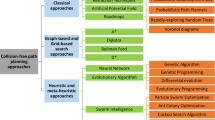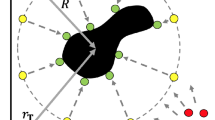Abstract
Because the state of a free-floating space robot model is uncertain and sudden changes in the model parameters might undermine the stability of the system, this paper proposes a control strategy based on a variable structure neural integrated controller. This scheme does not need a precise space robot model, making use of the radial basis function neural network ability approach to learn about an uncertain model. The network weights are adjusted online in real-time. During the early period of the control phase and parameter changes, the variable structure controller compensates for the uncertain model which the neural network could not learn well. It also creates global asymptotic stability for the whole closed-loop system. Simulation results show that the controller can handle bad changeable conditions and has important application value for defense, aerospace and other major security fields.
Similar content being viewed by others
References
King D. Space servicing: past, present and future. In: Proceedings of the 6th International Symposium on Artificial intelligence, Robot and Automation in Space, Montreal, Canada, 2001
Dubowsky S, Papadopoulos E G. The kinematics, dynamics and control of free-flying space robotic systems. IEEE Trans Robot Autom, 1993, 9: 531–543
Bejczy A K, Venkataraman S T. Introduction to the special issue on space robotics. IEEE Trans Robot Autom. 1993, 9: 521–523
Xu W B, Chen X B. Artificial moment method for swarm robot formation control. Sci China Ser F-Inf Sci, 2008, 51: 1521–1531
Zhuang Y, Gu M W, Wang W, et al. Multi-robot cooperative localization based on autonomous motion state estimation and laser data interaction. Sci China Tech Sci, 2010, 53: 2240–2250
Chen L. Adaptive and robust composite control of coordinated motion of space robot system with prismatic joint. In: Proceedings of the 4th World Congress on Intelligent Control and Automation, Shanghai, China, 2002, 2: 1255–1259
Duan Z H, Cai Z X, Yu J X. An adaptive particle filter for soft fault compensation of mobile robots. Sci China Ser F-Inf Sci, 2008, 51: 2033–2046
Cheah C C, Kawamura S, Lee K S A. H∞ tuning for task-space feedback control of robot with uncertain jacobean matrix. IEEE Trans Autom Control, 2001, 46: 1313–1318
Mokhtar S S, Hamid R M. A new impedance and robust adaptive inverse control approach for a tele-operation system with varying time delay. Sci China Ser E-Tech Sci, 2009, 52: 2629–2643
Gu Y L, Xu Y S. A normal form augmentation approach to adaptive control of space robot systems. In: Proceedings of the IEEE International Conference on Robotics and Automation, Atlanta, USA, 1993. 731–737
Lin C K. Non-singular terminal sliding model control of robot manipulators using fuzzy wavelet networks. IEEE Trans Fuzzy Syst, 2009, 160: 1765–1786
Wang S D, Lin C K. Adaptive control of robot manipulator using fuzzy compensator. Fuzzy Sets Syst, 2000, 110: 351–363
Wang C H, Tsai C H, Lin W S. Robust fuzzy model-following control of robot manipulators. IEEE Trans Fuzzy Syst, 2000, 8: 462–469
Lin C K. H∞ reinforcement learning control of robot manipulators using fuzzy wavelet networks. Fuzzy Sets Syst, 2009, 160: 1765–1786
Lewis F L, Kim Y H. Intelligent optimal control of robotic manipulators using neural networks. Automatica, 2000, 36: 1355–1364
Chen L. Adaptive and robust composite control of coordinated motion of space robot system with prismatic joint. In: Proceedings of the 4th World Congress on Intelligent Control and Automation, Shanghai, China, 2002, 2: 1255–1259
Gu Y, Xu Y S. A normal form augmentation approach to adaptive control of space robot systems. In: Proceedings of the IEEE International Conference on Robotics and Automation, Atlanta, USA, 1993. 731–737
Kim Y H, Lewis F L. Neural network output feedback control of robot manipulators. IEEE Trans Robot Autom, 1999, 15: 301–309
Xie J, Liu G L, Yan S Z, et al. Study on neural network adaptive control method for uncertain space manipulator. J Astronaut, 2010, 31: 123–129
Huang J Q, Lewis F L. Neural-network predictive control for nonlinear dynamic systems with time-delay. IEEE Trans Neural Netw, 2003, 14: 377–389
Hu H, Woo P Y. Fuzzy supervisory sliding-mode and neural-network control for robotic manipulators. IEEE Trans Indust Electron, 2006, 53: 929–940
Edgar N S, Miguel A B. Adaptive recurrent neural control for nonlinear system tracking. IEEE Trans Syst Man Cybern, Part B: Cybernetics, 2000, 30: 886–889
Sanner R M, Slotine J J E. Gaussian networks for direct adaptive control. IEEE Trans Neu Netw, 1992, 3: 837–863
Author information
Authors and Affiliations
Corresponding author
Rights and permissions
About this article
Cite this article
Zhang, W., Qi, N., Ma, J. et al. Neural integrated control for a free-floating space robot with suddenly changing parameters. Sci. China Inf. Sci. 54, 2091–2099 (2011). https://doi.org/10.1007/s11432-011-4420-7
Received:
Accepted:
Published:
Issue Date:
DOI: https://doi.org/10.1007/s11432-011-4420-7




